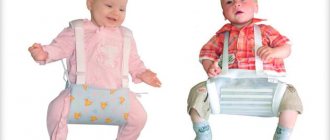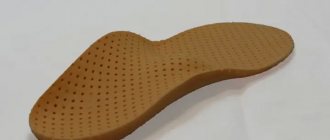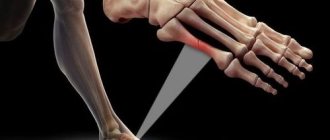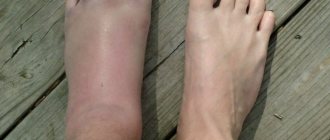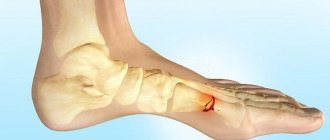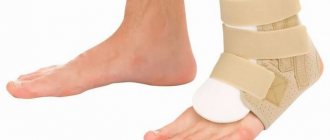General rules for walking on crutches
Different types of crutches are used for different situations. Usually, axillary crutches are used for the initial stage of rehabilitation after leg amputation, other operations, and plaster application. After completing the first stage of rehabilitation, when the patient is allowed to put minimal load on the injured limb, he can switch to elbow crutches, which are also called Canadian crutches.
It is important to choose the right shoes for walking on crutches. It is worth using familiar shoes that the person has worn before, so that the discomfort from using crutches is not added to the discomfort from new shoes. However, it is obvious that we are not talking about shoes with heels or high platforms. You should give preference to the most comfortable shoes for the season, which can be easily put on and taken off your feet, without complicated lacing or decorative elements.
When walking on crutches, you need to pay attention to the road . The ideal option is asphalt or a flat, compacted soil surface. Soft ground, grass, sand will not provide sufficiently solid support for crutches, and the patient may lose balance, and even a small stone or hole can cause a fall. You should move very carefully on wet or slippery surfaces.
During movement, it is necessary to pause and periodically rest , since the body is not accustomed to such loads, the muscles, especially the upper body, perform functions unusual for them, they are overstrained.
To use both axillary and elbow crutches, a person must have well-developed muscles of the arms, shoulder girdle, and torso. Doctors often advise frail and elderly people to use walkers instead of crutches.
Kinds
Crutches are prescribed to ensure patient mobility during treatment or during the rehabilitation process. Depending on the expected redistribution of body weight to the upper part of the body, a certain type is selected, which includes:
- shoulder or axillary;
- elbows.
For each patient with a specific disease of the lower extremities, appropriate medical devices are selected. How to walk on crutches, and which ones are better to choose? Their selection is made only by a specialist, taking into account the previous injury or surgical intervention.
Features of axillary species
If the patient, due to the severity of the fracture or surgery on large joints of the lower limb, cannot maintain his body weight, axillary products are better suited for this case. Their characteristic feature is that when walking on them, the weight of the body is completely transferred to the shoulder joint and axillary region.
This support is more reliable. The use of shoulder-based mobility aids completely eliminates the load on the injured lower limb. Their handle is placed in the armpit area parallel to the chest.
Sometimes soft tissue is laid over it to reduce armpit trauma, since the nerve plexus located in it is often subject to compression and provokes the development of “crutch paralysis.”
With support on the elbow
The most commonly used in rehabilitation practice are elbow crutches or crutches, in which the emphasis is on the hand and forearm. This type of device allows you to partially maintain body weight. This lightweight version of medical devices is recommended if it is impossible to use their axillary type.
Such aids during the rehabilitation period are considered as a transitional option from shoulder devices to a cane. For some patients, this type is a priority, since the medical industry produces several of the following modifications of crutches, which can be selected individually:
- adjustable option with changing the height of the entire product and the armrest;
- fixed view;
- one-piece option;
- collapsible modification (convenient for transportation).
The support of this type of crutches can be a simple tip or a more stable shape in the form of a pyramid. The handle on which the elbow rests can be of a standard configuration or made to fit the anatomical shape of the limb.
How to walk correctly on axillary crutches
The main condition for comfortable movement on crutches is their correct selection. There are two main criteria: the overall height of the crutch and the location of the palm rest.
To calculate the total height of the crutch, you need to subtract 40 cm from the person’s height (in cm). When measuring height, it is necessary that the person is wearing the shoes in which he will most often walk on crutches, or a sole height that is close to it. The crutch for measurement is not placed strictly vertically, but 15-20 cm to the side of the foot, and its top crossbar should be 4-5 cm below the armpit level.
To determine the location of the palm support, the patient leans on crutches, bending his arms at an angle of about 30 degrees. In this case, the crossbar should be at palm level. If a person stands with his arms straight down, the support should be slightly above the line of the wrists.
Correct selection of height is very important - if the crutches are too high, the pressure on the armpits increases. This, in addition to discomfort, abrasions, and rashes, can cause serious consequences. One of them is radial nerve palsy. This condition is characterized by weakness of the wrist and hand and loss of sensation in the back of the hand. Paralysis goes away after the pressure normalizes, but it is better to prevent its occurrence.
In order to move correctly on crutches, you need to remember a simple algorithm:
- Before moving around to get out of a chair or bed, crutches should be on the side of the injured leg. The patient grabs them from the inside, transfers one of the crutches to the other hand and, straightening the injured limb, carefully stands up.
- The patient places the crutches strictly vertically on the side of each leg. The width between the shoulder pads should be sufficient for the torso to fit between them. The palms are on the support.
- Leaning on both crutches, the patient transfers his body weight to his healthy leg.
- The crutches are moved forward one step at a time, then the person transfers the body weight to the crutches, moves the sore leg forward, at the same level as the crutches, holds it in weight or carefully leans on the foot or toe, and moves the healthy leg one step ahead of the sore one. The correct position of crutches when walking is not in close proximity to the foot, but at a distance of about 15-20 cm to the side.
- The patient rests the foot of his healthy leg on the floor or road and repeats the previous actions.
For those who are just learning to walk on crutches, it may be easier to start with shuttle walking. With this method, the crutches are first moved forward, then the patient transfers his body weight to them, leaning on his hands, and first pulls up the diseased and then the healthy leg.
The main emphasis on crutches is made not by the armpits, but by the palms, and it is necessary to use the muscles of the arms. But you shouldn’t squeeze the bar too tightly with your palms, as this can lead to numbness in your fingers and cramps.
When walking, you need to keep your head straight and your body as straight as possible, without bending your back. When turning, you should lean on your healthy leg. If you need to carry some things, it is better to use a backpack or a belt bag; a bag on your shoulder will interfere with movement. When climbing a hill, you need to make sure that the crutches do not remain behind the body.
Useful tips
To quickly replace your injured leg with crutches, you can use the following tips:
- If you find yourself on a slippery or oily surface, take very small steps so as not to let go of the crutches.
- Keep your eyes on the road! In ordinary life, you often don’t notice how much stuff can be under your feet. Rags, toys or completely unexpected obstacles can become a dangerous enemy.
- Avoid shoes with heels and other unstable models.
- Stop when traveling long distances to give your arms and legs a rest.
- Use a backpack to carry things, not a shoulder bag.
Do not hurry! Staying healthy is more important than avoiding being reprimanded for being late. Don’t be shy to ask for help from your loved ones who can provide you with insurance at first or help you adjust your crutches.
If you have questions that you have not received answers to either from our article or from friends, be sure to contact your doctor, but do not experiment with your health.
How to walk correctly on elbow crutches
Let us dwell on the rules for selecting arm crutches. The main task is to adjust the position of the cuffs and handles.
To check the position of the cuff, the patient stands up straight, places the crutch to the side 15 cm from the foot, and points his arm, bent at the elbow at an angle of 15-20 degrees, into the cuff. If the patient is about 1.7 m tall, the cuff should be at a distance of 5-7 cm from the elbow bend; if the patient is over 1.8 m tall, the distance should be about 10 cm; below 1.5 m – 4.5-5 cm. can also be performed while the patient is sitting. In this case, he puts the cuff on the arm and points the tip of the crutch straight up with the elbow bent 90 degrees. The width of the cuff is also important. It should not press or pinch your hand, and should not be overly wide.
The level of the palm handles is easy to check - with the patient standing straight with his arms down, the line of the wrist should correspond to the upper level of the handle. If the bend of the wrist is higher, then the crutches are shorter than necessary; if lower, the crutches are longer.
Walking on elbow crutches in general does not differ from walking on axillary crutches, with the difference that the fulcrum is in the elbow area. The crutches are alternately moved forward and slightly to the sides of the feet, while placing emphasis on the healthy leg, the sore leg is moved, then the healthy leg is taken a step.
Results
At first, an older person may not feel confident enough on crutches. There's nothing wrong with that. No matter how hard it is, over time he will get used to it and will begin to take short walks around the house and then decide to go outside.
If an elderly person still does not learn how to use crutches, there is another option - a walker. This is a safer way to travel. We talked about how to use walkers correctly in this publication.
In the private boarding house "Blago" your elderly relatives will be under round-the-clock supervision. For questions related to registration of residence, call the phone in Khabarovsk: 7 (4212) 69-16-48
How to walk up stairs on crutches correctly
An important condition for safe ascent and descent of stairs is that the patient must hold crutches in one hand and hold onto the railing with the other. In this case, you can use two crutches folded together as a support, or lean on one and hold the second under your arm. You need to go down and up slowly, keeping an eye on your body balance. To better understand the algorithm of ascent and descent, you can remember the expression: the healthy leg is always higher, and the sick leg is lower.
Climbing stairs:
- leaning on one side with a crutch on the floor or ground at the beginning of the ascent, and on the other hand holding the railing with his hand, the patient places his healthy leg on the step higher;
- moves the sore leg onto the same step;
- moves his crutches onto the step.
Descending the stairs:
- crutches are installed one step lower;
- the patient places the sore leg on the same step;
- moves his healthy leg there.
The duration of use of crutches depends on the severity of the injury and the complexity of the surgical intervention.
So, after joint replacement it is at least 6 weeks. After breaking your ankle, you may need to use crutches for 1 to 2 months. Therefore, the rules for using crutches are very important for comfortable and safe movement. All materials posted on the site are for informational purposes only and cannot be used as medical advice. To make a diagnosis and choose treatment methods, consult your doctor.
Where to buy, cost
You can buy crutches in pharmacies, medical equipment and orthopedics stores; their price depends on the material, size, additional devices, and varies from 300 to 6,000 rubles. For temporary use there is a free rental, and for disabled people and veterans the social service center provides free rental.
In order for crutches to be a reliable and comfortable means of movement, you need to choose them on the recommendation of a doctor, adjust and customize them for yourself, and master the skills of proper use.
How to quickly learn to walk on crutches and avoid mistakes
Purpose and design
Crutches are medical devices aimed at ensuring the activity and mobility of patients during treatment or the rehabilitation period. Their purpose is shown in the following states:
- pathology of the lower extremities;
- injuries of various types;
- dysfunction of the musculoskeletal system;
- severe diseases of internal organs.
The selection of these funds is carried out according to the height and weight of the patients. The materials used to make the products are wood, metal or plastic. By design, an axillary crutch is a U-shaped product, consisting of an armpit support, a round tip with an anti-slip coating, and a crossbar in the middle of the crutch.
In some modifications it can be movable, moving in height. If the material used for its manufacture is aluminum or plastic, then there must be a mechanism for adjusting the product to the specific height of the patient.
It is this design of a medical device that is indicated during the recovery period after severe injuries of the lower extremities, as they have greater reliability due to their length and the ability to relieve stress from the sore limb as much as possible.

